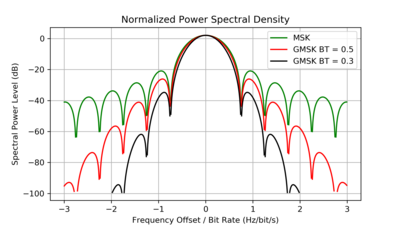Minimum-shift keying
| Passband modulation |
|---|
 |
| Analog modulation |
| Digital modulation |
| Hierarchical modulation |
| Spread spectrum |
| See also |
In
However, instead of square pulses as OQPSK uses, MSK encodes each bit as a half
In MSK the difference between the higher and lower frequency is identical to half the bit rate. Consequently, the waveforms used to represent a 0 and a 1 bit differ by exactly half a carrier period. Thus, the maximum frequency deviation is δ = 0.5 fm where fm is the maximum modulating frequency. As a result, the modulation index m is 0.5. This is the smallest FSK
Mathematical representation
This section needs additional citations for verification. (April 2020) |

The resulting signal is represented by the formula:[3][failed verification]
where and encode the even and odd information respectively with a sequence of square pulses of duration 2T. has its pulse edges on and on . The
Using the
where bk(t) is +1 when and −1 if they are of opposite signs, and is 0 if is 1, and otherwise. Therefore, the signal is modulated in frequency and phase, and the phase changes continuously and linearly.
Properties
Since the minimum symbol distance is the same as in the QPSK,[7][6] the following formula can be used for the theoretical bit-error ratio bound:
where is the energy per one bit, is the noise spectral density, denotes the Q-function and denotes the complementary error function.
Gaussian minimum-shift keying

Gaussian minimum-shift keying, or GMSK, is similar to standard minimum-shift keying (MSK); however, the digital data stream is first shaped with a Gaussian filter before being applied to a frequency modulator, and typically has much narrower phase shift angles than most MSK modulation systems. This has the advantage of reducing sideband power, which in turn reduces out-of-band interference between signal carriers in adjacent frequency channels.[9]
However, the Gaussian filter increases the modulation memory in the system and causes
See also
- Constellation diagram used to examine the modulation in signal space (not time)
- Gaussian frequency-shift keying
References
- ^ M.L Doelz and E.T. Heald, Minimum Shift Data Communication System, US Patent 2977417, 1958, http://www.freepatentsonline.com/2977417.html
- ^ Anderson J. B., Aulin T., Sundberg C. E. Digital phase modulation. – Springer Science & Business Media, 2013. – p.49–50
- ^ a b Proakis, John G. (2001). Digital Communication (4 ed.). McGraw-Hill Inc. pp. 196-199.
- ^ Proakis J. G. Digital communications. 1995 //McGraw-Hill, New York. – p. 126-128
- ^ Anderson J. B., Aulin T., Sundberg C. E. Digital phase modulation. – Springer Science & Business Media, 2013. – p. 49-50
- ^ a b Link Budget Analysis: Digital Modulation-Part 2-FSK (Atlanta RF)
- ^ Haykin, S., 2001. Communication Systems, John Wiley&Sons. Inc. - p. 394
- ^ Haykin, S., 2001. Communication Systems, John Wiley&Sons. Inc. - p. 398
- ^ Poole, Ian. "What is GMSK Modulation - Gaussian Minimum Shift Keying". RadioElectronics.com. Retrieved March 23, 2014.
- ^ Rice, M., Oliphant, T., & Mcintire, W. (2007). Estimation techniques for GMSK using linear detectors in satellite communications. IEEE Transactions on Aerospace and Electronic Systems, 43(4).
- ^ Wong, Yen F., et al. "An optimum space-to-ground communication concept for CubeSat platform utilizing NASA space network and near earth network." (2016).
- Subbarayan Pasupathy, Minimum Shift Keying: A Spectrally Efficient Modulation, IEEE Communications Magazine, 1979
- R. de Buda, Fast FSK Signals and their Demodulation, Can. Elec. Eng. J. Vol. 1, Number 1, 1976
- F. Amoroso, Pulse and Spectrum Manipulation in the Minimum (Frequency) Shift Keying (MSK) Format, IEEE Trans.
- "Appendix D – Digital Modulation and GMSK" (PDF). University of Hull. 2001-03-13. Archived from the original (PDF) on 2004-09-24.
- Link Budget Analysis: Digital Modulation-Part 2-FSK (Atlanta RF)
- Elnoubi, S., Chahine, S. A., & Abdallah, H. (2004, March). BER performance of GMSK in Nakagami fading channels. In Radio Science Conference, 2004. NRSC 2004. Proceedings of the Twenty-First National (pp. C13-1). IEEE.
- Feher, K. (1993, July). FQPSK: A modulation-power efficient RF amplification proposal for increased spectral efficiency and capacity GMSK and Π/4-QPSK compatible PHY standard. In IEEE 802.11 Wireless Access Methods Phys. Layer Spec. Doc.




![{\displaystyle t=[-T,T,3T,\ldots ]}](https://wikimedia.org/api/rest_v1/media/math/render/svg/13a9172df01228649a659486105daaafbbe187d2)
![{\displaystyle t=[0,2T,4T,\ldots ]}](https://wikimedia.org/api/rest_v1/media/math/render/svg/9bac49ff3eb5f073c59a8a2b88a36c09294a8a53)

![{\displaystyle s(t)=\cos \left[2\pi f_{c}t+b_{k}(t){\frac {\pi t}{2T}}+\phi _{k}\right]}](https://wikimedia.org/api/rest_v1/media/math/render/svg/e0bf9845ccc229590a3bf8c2fb3cac760b8f5f5d)








